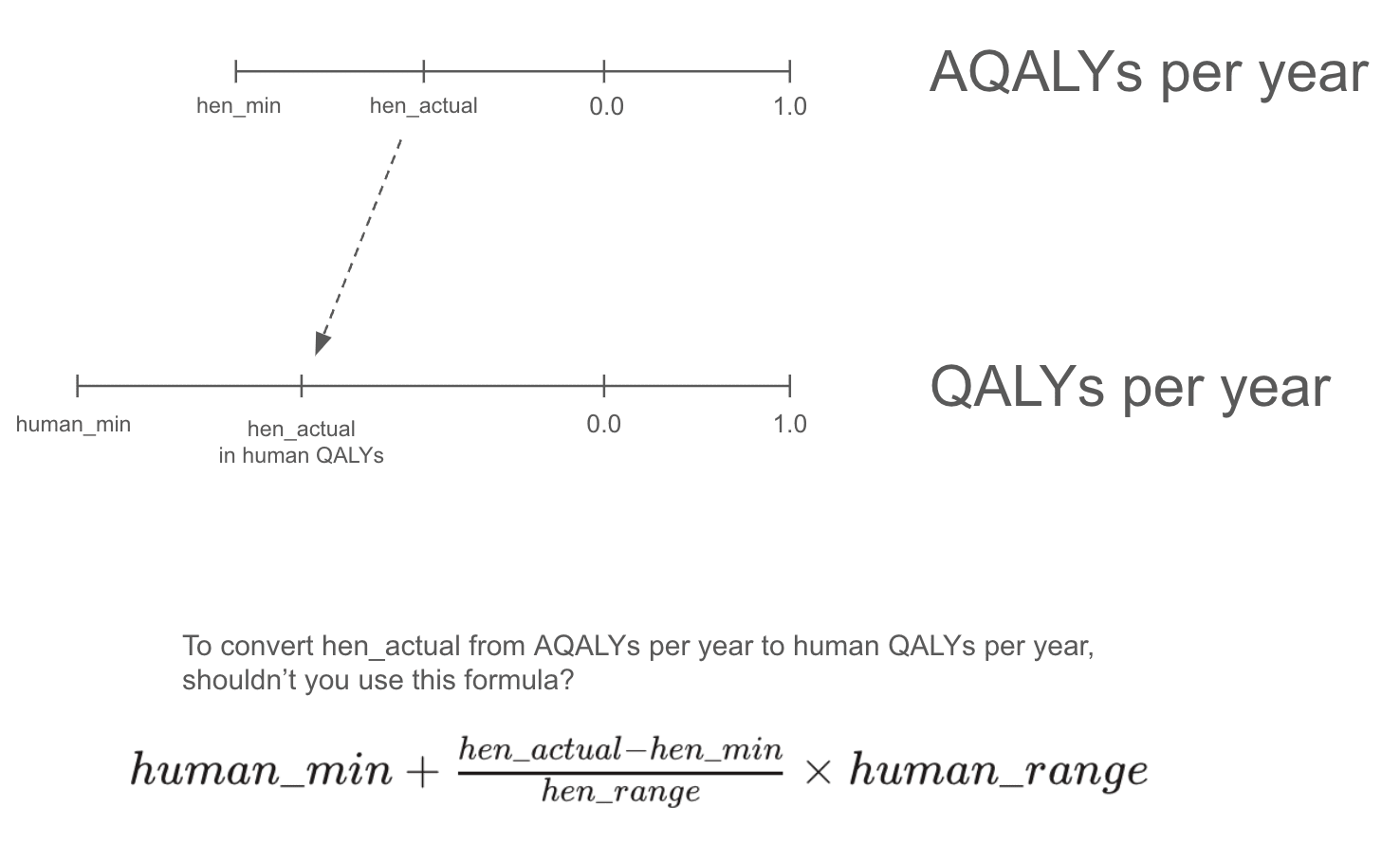Summary
- I calculated the welfare ranges per calorie consumption for a few species.
- They vary a lot. The values for bees and pigs are 4.88 k and 0.473 times as high as that for humans.
- They are higher for non-human animals:
- 5 of the 6 species I analysed have values higher than that of humans.
- The lower the calorie consumption, the higher the median welfare range per calorie consumption.
Methods
I calculated the welfare ranges per calorie consumption from the ratio between:
- Rethink Priorities’ 5th percentile, median, and 95th percentile welfare ranges.
- Calorie consumption per day for mature individuals. Note there is variation within the same species.
My calculations are here.
Results
The results are below by descending median welfare range per calorie consumption.
Welfare range and calorie consumption
Species | 5th percentile welfare range | Median welfare range | 95th percentile welfare range | Calorie consumption (kcal/d) |
|---|---|---|---|---|
Bees[1] | 0 | 0.071 | 0.461 | 0.0327 |
Shrimp[2] | 0 | 0.031 | 1.149 | 0.831 |
Crayfish[3] | 0 | 0.038 | 0.491 | 4.88 |
Salmon[4] | 0 | 0.056 | 0.513 | 34.9 |
Chickens[5] | 0.002 | 0.332 | 0.869 | 300 |
Humans[6] | 1 | 1 | 1 | 2.25 k |
Pigs[7] | 0.005 | 0.515 | 1.031 | 2.45 k |
Welfare range per calorie consumption
Species | 5th percentile welfare range per calorie consumption (d/kcal) | Median welfare range per calorie consumption (d/kcal) | 95th percentile welfare range per calorie consumption (d/kcal) |
|---|---|---|---|
Bees | 0 | 2.17 | 14.1 |
Shrimp | 0 | 0.0373 | 1.38 |
Crayfish | 0 | 7.79 m | 0.101 |
Salmon | 0 | 1.61 m | 0.0147 |
Chickens | 6.67 μ | 1.11 m | 2.90 m |
Humans | 0.444 m | 0.444 m | 0.444 m |
Pigs | 2.04 μ | 0.210 m | 0.421 m |
Species | 5th percentile welfare range per calorie consumption as a fraction of that of humans | Median welfare range per calorie consumption as a fraction of that of humans | 95th percentile welfare range per calorie consumption as a fraction of that of humans |
|---|---|---|---|
Bees | 0 | 4.88 k | 31.7 k |
Shrimp | 0 | 83.9 | 3.11 k |
Crayfish | 0 | 17.5 | 226 |
Salmon | 0 | 3.61 | 33.1 |
Chickens | 1.50 % | 2.49 | 6.52 |
Humans | 1.00 | 1.00 | 1.00 |
Pigs | 0.459 % | 47.3 % | 94.7 % |
Discussion
The median welfare ranges per calorie consumption vary a lot. The values for bees and pigs are 4.88 k and 0.473 times as high as that for humans[8].
In addition, the values are higher for non-human animals. 5 of the 6 species I analysed have values higher than that of humans. Moreover, the lower the calorie consumption, the higher the median welfare range per calorie consumption. These suggest welfare can be created more efficiently via small non-human animals. However, one should also account for:
- The energy needed besides that in food.
- The level of welfare as a fraction of the median welfare range.
I would still guess that it is possible to achieve higher total welfare with mostly small non-human animals, in agreement with animal welfare arguably being dominated by that of arthropods and nematodes. In the future, one might be able to produce welfare much more efficiently via non-biological beings.
- ^
According to Mark Patterson, “in summer a full strength Honey Bee hive contains around 50-60,000 workers and needs to consume around 1800 calories per day”. So I used 0.0327 kcal/d (= 1.8/((50 + 60)/2)).
- ^
A shrimp of 40 g is fed 0.84 g/d (= 0.021*40), and shrimp feed has 0.989 kcal/g (= 84/(3*28.3)). So I used 0.831 kcal/d (= 0.84*0.989).
- ^
- ^
“After two years at sea”, adult salmon have “8 to 12 pounds”, so it grows 6.21 g/d (= (8 + 12)/2*454/(2*365.25)). In addition, “Atlantic salmon needs 1.15 kg feed to gain 1 kg body weight”, which translates into 7.15 g/d (= 6.21*1.15) of feed, which contains 4.88 kcal/g (= (0.356 + 0.110)*4 + 0.335*9). So I used 34.9 kcal/d (= 7.15*4.88).
- ^
According to Ken Macklin and Joe Hess, “a hen may consume up to 340 calories of metabolizable energy per day during winter to keep warm. But in summer, she may consume only 260 calories of metabolizable energy per day”. So I used 300 kcal/d (= (260 + 340)/2).
- ^
According to the National Health Service, “the recommended daily calorie intake is 2,000 calories a day for women and 2,500 for men”. So I used 2.25 k kcal/d (= (2 k + 2.5 k)/2).
- ^
Mean between the lower and upper bounds of 2.4 k and 2.5 k for breeder pigs.
- ^
Fun fact, I was stung by a bee/wasp just today.



I am glad you found it interesting, Laura!
To clarify, my post is about the calories consumed by the animals, not about the animal calories consumed by humans. However, I agree running a similar analysis for the calories provided per animal, and then factoring in their lifespan (and median welfare range, and ideally quality of life) would be quite interesting too! Just in case you are not aware, Brian Tomasik has a piece about "equivalent days of suffering caused per kg demanded". There is a website which weights days of suffering by various functions of the number of neurons, and also accounted for climate change, but I do not remember the name (Michael St. Jules should know). Maybe they could add an option to weight by Rethink's median welfare ranges.
I was thinking about welfare ranges per calories consumed by the animals with the goal of getting a sense of what type of beings would fill the world in order to increase welfare. For a given amount of energy, and welfare as a fraction of the welfare range, it looks like feeding bees produces much more welfare than feeding humans. Nevertheless, I do not think one should start tilling the universe with bees just yet! This is only one of many factors to consider.